Geographic Wonders of Hamlet’s Home
updated 27 July
Here’s how Denmark looks from space
including most of the islands between Denmark’s peninsula and Sweden
(with lines of small clouds scattered across southern Sweden)
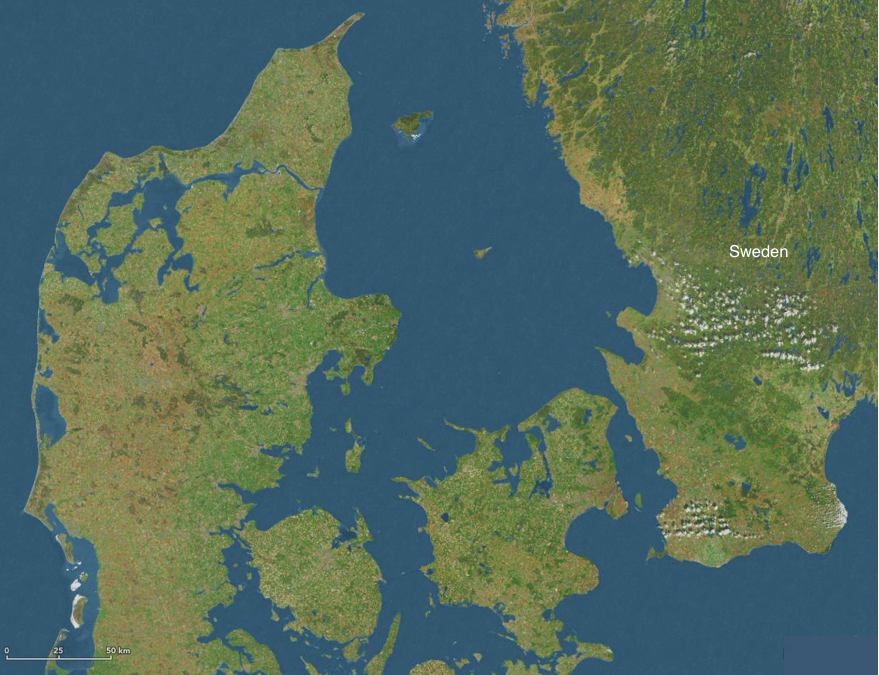
If you’re seeing outlines of figures, perhaps heads and/or animals, you might appreciate this site’s musings on this page.
Arrow below points to Helsingør, the capital of Hamlet’s kingdom*
at the closest Denmark gets to Sweden. *many centuries ago
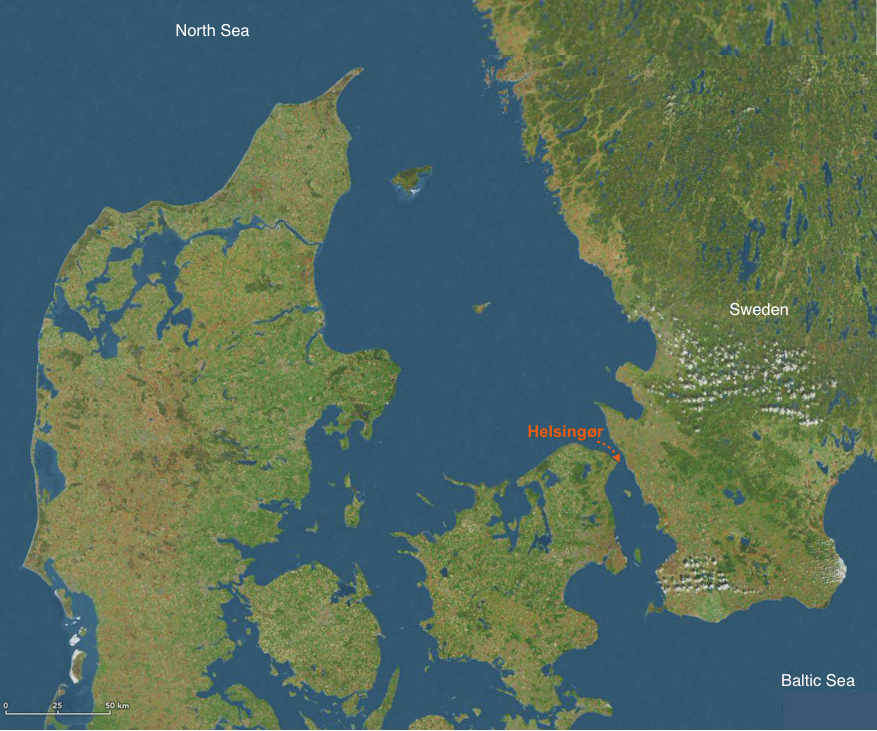
See below for why Shakespeare invented the spelling “Elsinore.”
Helsingør is a combination of three Danish words:
| English: | |
|---|---|
| Hels | throat |
| sing | sing |
| ør | earring |
(The surviving descendant of Hamlet’s Kronborg Castle* is at the very tip of Helsingør, occupying Kronborg Point
where Denmark’s shore is closest to Sweden across the Øresund strait, the channel separating the two countries.**
*The Castle page includes detailed maps, pictures of the impressive Renaissance-era castle,
plus links to additional sites, including the Shakespeare festival the castle hosts each summer.
**Also the main ship passage between the North and Baltic Seas. more below)
Apparently those who named this uniquely special geographic site
sensed something musical if not resoundingly ringing, singing there:
— There are also strong currents ever flowing forth from the Baltic, preventing it from becoming far saltier:
If the triangular land mass culminating at Helsingør did not greatly constrict the strait,
Øresund would be by far the Baltic’s main outflow, with much increased opportunities
for oceanic waters to enter it, threatening its relative freshness. —
Could the below anatomic correspondences just be coincidence with where sound flows forth from human beings?

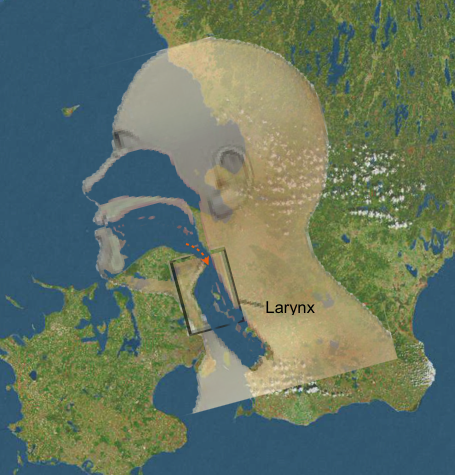


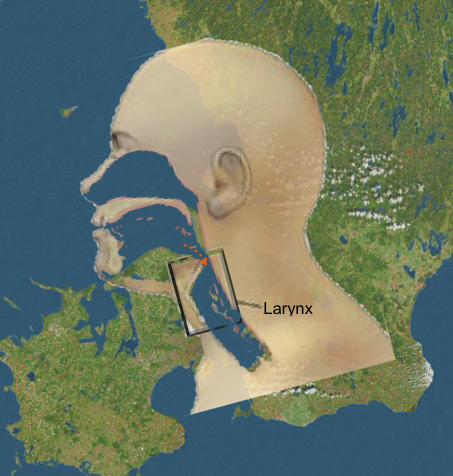
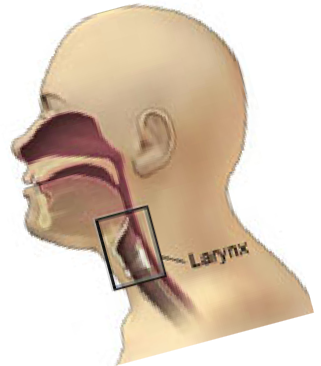
The point at Helsingør restricts flows to keep the Baltic fresh, similar to how
the larynx restricts and modulates flows of air from ones lungs to produce speech and singing.
Helsingør’s Hamlet wonders have also been sounding forth, for more than four centuries now,
thanks to The Bard.
Air exhaled through the larynx also contains pure water vapor, similar to the Baltic’s much fresher waters a small fraction of ocean salinity, especially in its most northern and eastern arms.
Those familiar with spiritual science know animalic astral forces dominate in Earth’s salty ocean ( – yes, there is only one) where even the landscapes are predominantly animals called coral, and plants are almost always brown if not withered like dying leaves.*
Pure water exhaled in human breath has been freed from captivity in the body’s salty inner oceans of blood and lymph.
The Baltic’s much less salty, more plant-like, etheric waters bestow cleansing, purifying, enlivening influences on the ocean.
The Øresund or Ear sound (strait) undoubtedly helps the ocean remain healthy and sound, to some extent.
*in contrast to land where the etheric world of plants dominate
(as do human beings as well).
Why Shakespeare changed Helsingør to Elsinore has been the subject of much speculation.
There are good reasons to think he deliberately employed one of the Hebrew words for God, El.
But he dropped the g as if he did not wish the implication of singing.
Sinor is a Hebrew word for apron. (Adding “e” makes sure English speakers pronounce it with a long “oh” sound, not like “sinner.”)
Apron meanings include an edge or border; an apron one wears is also like a curtain that makes separate what it protects.
Hamlet’s kingdom, its locus, is on the border, the threshold to God, to higher, spiritual knowledge,
to the world of spirit especially Western humanity has become separated from like never before..
Its geographic location is traditionally associated with singing and hearing, and exhibits
forms and functions similar to the human larynx, the organ of singing and speaking: expressions of
the Logos, the Word.
It thus seems little to no coincidence to find a great cross centered on Helsingør:
A Great Watery Crossing Point and Crossroads
Locus of Exceptional Human Harmony and Prosperity
Fortinbras’ army marching through Elsinore on its way to Poland (Act 4) illustrates Helsingør’s strategic geographic location:
As the shortest water crossing between the Nordic peninsula and Denmark, thence northern Europe’s mainland, Helsingør has been a major thoroughfare for goods and people since before history, as the below image demonstrates.
Ship traffic traveling primarily east-west linking the North Sea with Russia, Poland, and other ports on the Baltic, intersects overland trade with the Nordic countries moving primarily north-south to mainland Europe. (See the broader regional image at bottom that better demonstrates the primary directions of travel match the four compass points.)

Helsingør has thus been a unique locus where East and West, North and South have met and intermingled for untold ages.
One can thus better understand how Danes have traditionally been one of Earth’s most tolerant and open-minded peoples.
Their broader perspectives are further confirmed by Denmark becoming the first entire nation to reject Catholic tyrannies, embracing Luther’s Reformation in 1536.
Several aspects of the play actually reference these historic shifts still very much underway during Shakespeare’s life, but the much less extensive Reformation in England meant Shakespeare had to veil his admiration, as evident in some of Hamlet’s more outrageous and baffling lines.
It thus seems more than coincidence Elsinore is EXACTLY north of Wittenberg:
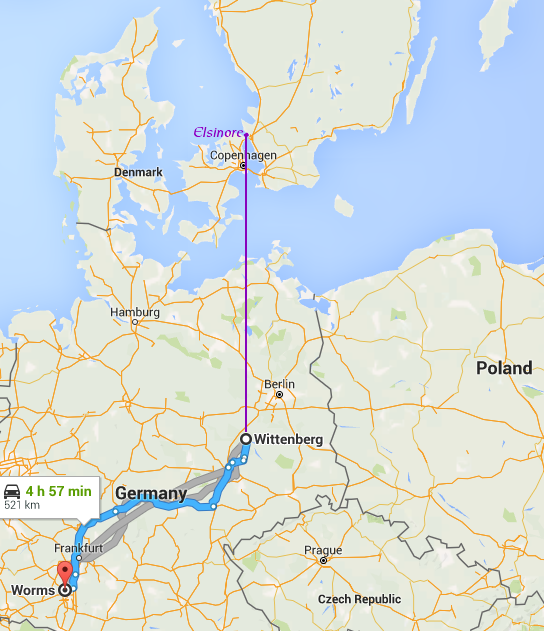
And both exactly north of the Vatican! (within 0.1 degrees!):

It also seems relevant Denmark consistently ranks at or near the top of nations in contemporary surveys of overall happiness and well-being, although a number of other countries are wealthier per capita. E.g, here’s Forbes list.
The other Nordic countries plus Holland also rank highly.
Anthroposophical initiatives have also found fertile cultural and social soil in Scandinavian countries.
There thus seem a number of factors Shakespeare may have had in mind when choosing a name meaning God’s Threshold. This special locus seems comparatively Divine in a number of ways.
As the above image of trade routes demonstrates, this great crossing point of travel plus shipping routes via land and sea (primarily along the four compass points) must rotate almost 90 degrees to the right to negotiate the islands between Denmark’s peninsula and Sweden, and to negotiate the Øresund channel linking the Baltic and North Seas.
Denmark is thus a rather large barrier requiring considerable care and trouble to negotiate to cross this great meeting of East and West, North and South.
This relative barrier to travel, trade, and cultural exchange is a major reason the cultures on the Nordic peninsula remained distinct from the rest of Europe, and also further distanced the northern edge of Eastern Europe plus Russia from contact with Western Europe.
– Please note the bent arms of the cross centered at Helsingør are shifted opposite those of a Swastika. –
Less obvious but also perhaps not coincidence: When one considers much of the trade crossing at Helsingør has been food, one can notice an analogy with air traveling from the back of the nose to the lungs crossing the pathway of food to the esophagus (thence to the stomach) – at times a deadly quirk of human anatomy when more than air gets inhaled.
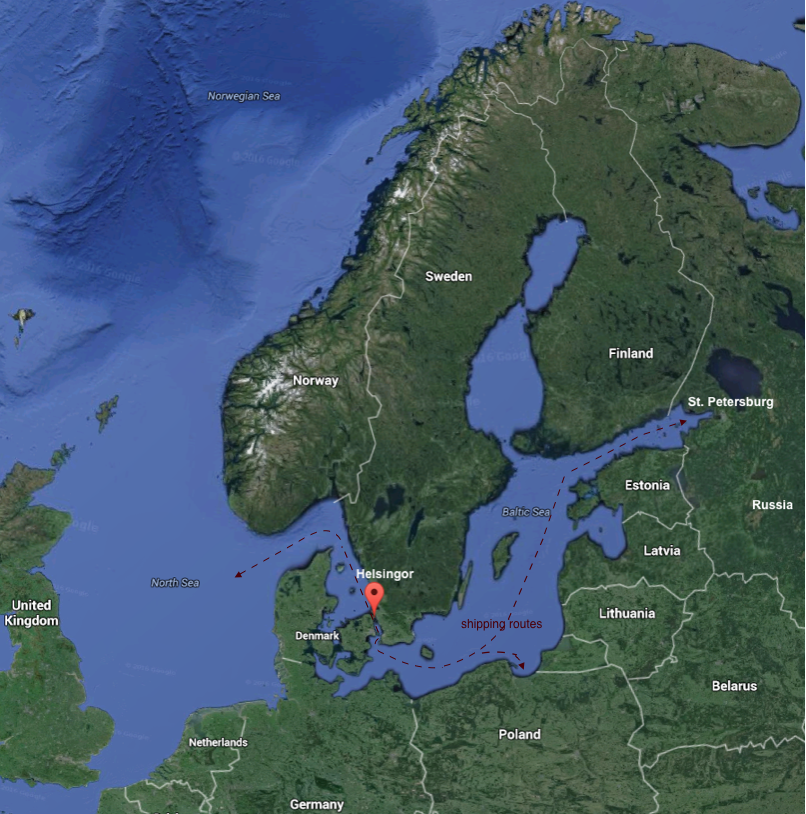
Sinor is a Hebrew word for apron. (Adding “e” makes sure English speakers pronounce it with a long “oh” sound, not like “sinner.”)
Apron meanings include an edge or border; an apron one wears is also like a curtain that makes separate what it protects.
Hamlet’s kingdom, its locus, is on the border, the threshold to God, to higher, spiritual knowledge,
to the world of spirit especially Western humanity has become separated from like never before..
Its geographic location is traditionally associated with singing and hearing, and exhibits
forms and functions similar to the human larynx, the organ of singing and speaking: expressions of
the Logos, the Word.
It thus seems little to no coincidence to find a great cross centered on Helsingør:
A Great Watery Crossing Point and Crossroads
Locus of Exceptional Human Harmony and Prosperity
Fortinbras’ army marching through Elsinore on its way to Poland (Act 4) illustrates Helsingør’s strategic geographic location:
As the shortest water crossing between the Nordic peninsula and Denmark, thence northern Europe’s mainland, Helsingør has been a major thoroughfare for goods and people since before history, as the below image demonstrates.
Ship traffic traveling primarily east-west linking the North Sea with Russia, Poland, and other ports on the Baltic, intersects overland trade with the Nordic countries moving primarily north-south to mainland Europe. (See the broader regional image at bottom that better demonstrates the primary directions of travel match the four compass points.)

Helsingør has thus been a unique locus where East and West, North and South have met and intermingled for untold ages.
One can thus better understand how Danes have traditionally been one of Earth’s most tolerant and open-minded peoples.
Their broader perspectives are further confirmed by Denmark becoming the first entire nation to reject Catholic tyrannies, embracing Luther’s Reformation in 1536.
Several aspects of the play actually reference these historic shifts still very much underway during Shakespeare’s life, but the much less extensive Reformation in England meant Shakespeare had to veil his admiration, as evident in some of Hamlet’s more outrageous and baffling lines.
It thus seems more than coincidence Elsinore is EXACTLY north of Wittenberg:

And both exactly north of the Vatican! (within 0.1 degrees!):

It also seems relevant Denmark consistently ranks at or near the top of nations in contemporary surveys of overall happiness and well-being, although a number of other countries are wealthier per capita. E.g, here’s Forbes list.
The other Nordic countries plus Holland also rank highly.
Anthroposophical initiatives have also found fertile cultural and social soil in Scandinavian countries.
There thus seem a number of factors Shakespeare may have had in mind when choosing a name meaning God’s Threshold. This special locus seems comparatively Divine in a number of ways.
As the above image of trade routes demonstrates, this great crossing point of travel plus shipping routes via land and sea (primarily along the four compass points) must rotate almost 90 degrees to the right to negotiate the islands between Denmark’s peninsula and Sweden, and to negotiate the Øresund channel linking the Baltic and North Seas.
Denmark is thus a rather large barrier requiring considerable care and trouble to negotiate to cross this great meeting of East and West, North and South.
This relative barrier to travel, trade, and cultural exchange is a major reason the cultures on the Nordic peninsula remained distinct from the rest of Europe, and also further distanced the northern edge of Eastern Europe plus Russia from contact with Western Europe.
– Please note the bent arms of the cross centered at Helsingør are shifted opposite those of a Swastika. –
Less obvious but also perhaps not coincidence: When one considers much of the trade crossing at Helsingør has been food, one can notice an analogy with air traveling from the back of the nose to the lungs crossing the pathway of food to the esophagus (thence to the stomach) – at times a deadly quirk of human anatomy when more than air gets inhaled.

Hamlet’s kingdom, its locus, is on the border, the threshold to God, to higher, spiritual knowledge,
to the world of spirit especially Western humanity has become separated from like never before..
Its geographic location is traditionally associated with singing and hearing, and exhibits
forms and functions similar to the human larynx, the organ of singing and speaking: expressions of
the Logos, the Word.
It thus seems little to no coincidence to find a great cross centered on Helsingør:
A Great Watery Crossing Point and Crossroads
Locus of Exceptional Human Harmony and Prosperity
Fortinbras’ army marching through Elsinore on its way to Poland (Act 4) illustrates Helsingør’s strategic geographic location:
As the shortest water crossing between the Nordic peninsula and Denmark, thence northern Europe’s mainland, Helsingør has been a major thoroughfare for goods and people since before history, as the below image demonstrates.
Ship traffic traveling primarily east-west linking the North Sea with Russia, Poland, and other ports on the Baltic, intersects overland trade with the Nordic countries moving primarily north-south to mainland Europe. (See the broader regional image at bottom that better demonstrates the primary directions of travel match the four compass points.)

Helsingør has thus been a unique locus where East and West, North and South have met and intermingled for untold ages.
One can thus better understand how Danes have traditionally been one of Earth’s most tolerant and open-minded peoples.
Their broader perspectives are further confirmed by Denmark becoming the first entire nation to reject Catholic tyrannies, embracing Luther’s Reformation in 1536.
Several aspects of the play actually reference these historic shifts still very much underway during Shakespeare’s life, but the much less extensive Reformation in England meant Shakespeare had to veil his admiration, as evident in some of Hamlet’s more outrageous and baffling lines.
It thus seems more than coincidence Elsinore is EXACTLY north of Wittenberg:

And both exactly north of the Vatican! (within 0.1 degrees!):

It also seems relevant Denmark consistently ranks at or near the top of nations in contemporary surveys of overall happiness and well-being, although a number of other countries are wealthier per capita. E.g, here’s Forbes list.
The other Nordic countries plus Holland also rank highly.
Anthroposophical initiatives have also found fertile cultural and social soil in Scandinavian countries.
There thus seem a number of factors Shakespeare may have had in mind when choosing a name meaning God’s Threshold. This special locus seems comparatively Divine in a number of ways.
As the above image of trade routes demonstrates, this great crossing point of travel plus shipping routes via land and sea (primarily along the four compass points) must rotate almost 90 degrees to the right to negotiate the islands between Denmark’s peninsula and Sweden, and to negotiate the Øresund channel linking the Baltic and North Seas.
Denmark is thus a rather large barrier requiring considerable care and trouble to negotiate to cross this great meeting of East and West, North and South.
This relative barrier to travel, trade, and cultural exchange is a major reason the cultures on the Nordic peninsula remained distinct from the rest of Europe, and also further distanced the northern edge of Eastern Europe plus Russia from contact with Western Europe.
– Please note the bent arms of the cross centered at Helsingør are shifted opposite those of a Swastika. –
Less obvious but also perhaps not coincidence: When one considers much of the trade crossing at Helsingør has been food, one can notice an analogy with air traveling from the back of the nose to the lungs crossing the pathway of food to the esophagus (thence to the stomach) – at times a deadly quirk of human anatomy when more than air gets inhaled.

forms and functions similar to the human larynx, the organ of singing and speaking: expressions of
the Logos, the Word.
It thus seems little to no coincidence to find a great cross centered on Helsingør:
A Great Watery Crossing Point and Crossroads
Locus of Exceptional Human Harmony and Prosperity
Fortinbras’ army marching through Elsinore on its way to Poland (Act 4) illustrates Helsingør’s strategic geographic location:
As the shortest water crossing between the Nordic peninsula and Denmark, thence northern Europe’s mainland, Helsingør has been a major thoroughfare for goods and people since before history, as the below image demonstrates.
Ship traffic traveling primarily east-west linking the North Sea with Russia, Poland, and other ports on the Baltic, intersects overland trade with the Nordic countries moving primarily north-south to mainland Europe. (See the broader regional image at bottom that better demonstrates the primary directions of travel match the four compass points.)

Helsingør has thus been a unique locus where East and West, North and South have met and intermingled for untold ages.
One can thus better understand how Danes have traditionally been one of Earth’s most tolerant and open-minded peoples.
Their broader perspectives are further confirmed by Denmark becoming the first entire nation to reject Catholic tyrannies, embracing Luther’s Reformation in 1536.
Several aspects of the play actually reference these historic shifts still very much underway during Shakespeare’s life, but the much less extensive Reformation in England meant Shakespeare had to veil his admiration, as evident in some of Hamlet’s more outrageous and baffling lines.
It thus seems more than coincidence Elsinore is EXACTLY north of Wittenberg:

And both exactly north of the Vatican! (within 0.1 degrees!):

It also seems relevant Denmark consistently ranks at or near the top of nations in contemporary surveys of overall happiness and well-being, although a number of other countries are wealthier per capita. E.g, here’s Forbes list.
The other Nordic countries plus Holland also rank highly.
Anthroposophical initiatives have also found fertile cultural and social soil in Scandinavian countries.
There thus seem a number of factors Shakespeare may have had in mind when choosing a name meaning God’s Threshold. This special locus seems comparatively Divine in a number of ways.
As the above image of trade routes demonstrates, this great crossing point of travel plus shipping routes via land and sea (primarily along the four compass points) must rotate almost 90 degrees to the right to negotiate the islands between Denmark’s peninsula and Sweden, and to negotiate the Øresund channel linking the Baltic and North Seas.
Denmark is thus a rather large barrier requiring considerable care and trouble to negotiate to cross this great meeting of East and West, North and South.
This relative barrier to travel, trade, and cultural exchange is a major reason the cultures on the Nordic peninsula remained distinct from the rest of Europe, and also further distanced the northern edge of Eastern Europe plus Russia from contact with Western Europe.
– Please note the bent arms of the cross centered at Helsingør are shifted opposite those of a Swastika. –
Less obvious but also perhaps not coincidence: When one considers much of the trade crossing at Helsingør has been food, one can notice an analogy with air traveling from the back of the nose to the lungs crossing the pathway of food to the esophagus (thence to the stomach) – at times a deadly quirk of human anatomy when more than air gets inhaled.

Several aspects of the play actually reference these historic shifts still very much underway during Shakespeare’s life, but the much less extensive Reformation in England meant Shakespeare had to veil his admiration, as evident in some of Hamlet’s more outrageous and baffling lines.
It thus seems more than coincidence Elsinore is EXACTLY north of Wittenberg:

And both exactly north of the Vatican! (within 0.1 degrees!):

It also seems relevant Denmark consistently ranks at or near the top of nations in contemporary surveys of overall happiness and well-being, although a number of other countries are wealthier per capita. E.g, here’s Forbes list.
The other Nordic countries plus Holland also rank highly.
Anthroposophical initiatives have also found fertile cultural and social soil in Scandinavian countries.
There thus seem a number of factors Shakespeare may have had in mind when choosing a name meaning God’s Threshold. This special locus seems comparatively Divine in a number of ways.
As the above image of trade routes demonstrates, this great crossing point of travel plus shipping routes via land and sea (primarily along the four compass points) must rotate almost 90 degrees to the right to negotiate the islands between Denmark’s peninsula and Sweden, and to negotiate the Øresund channel linking the Baltic and North Seas.
Denmark is thus a rather large barrier requiring considerable care and trouble to negotiate to cross this great meeting of East and West, North and South.
This relative barrier to travel, trade, and cultural exchange is a major reason the cultures on the Nordic peninsula remained distinct from the rest of Europe, and also further distanced the northern edge of Eastern Europe plus Russia from contact with Western Europe.
– Please note the bent arms of the cross centered at Helsingør are shifted opposite those of a Swastika. –
Less obvious but also perhaps not coincidence: When one considers much of the trade crossing at Helsingør has been food, one can notice an analogy with air traveling from the back of the nose to the lungs crossing the pathway of food to the esophagus (thence to the stomach) – at times a deadly quirk of human anatomy when more than air gets inhaled.


And both exactly north of the Vatican! (within 0.1 degrees!):
